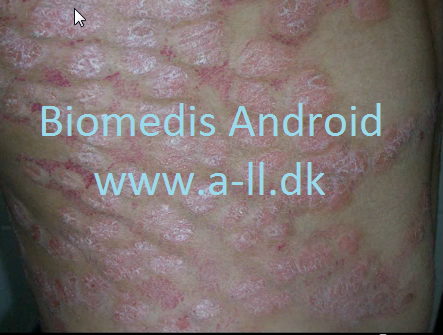Psoriasis is a chronic skin disease characterized by red patches on the skin, often accompanied by silvery-white scales of dead skin cells. It is not contagious.
Psoriasis is believed to be an autoimmune disease, meaning the body’s defense system attacks healthy cells in the body. This creates skin cells that mature and die in less than a week, which is extremely rapid considering normal skill cells mature and replace dead ones usually in a month’s time.
Psoriasis is believed to be an autoimmune disease, meaning the body’s defense system attacks healthy cells in the body. This creates skin cells that mature and die in less than a week, which is extremely rapid considering normal skill cells mature and replace dead ones usually in a month’s time.
The buildup of dead cells on the skin’s surface is called plaque. While these can occur anywhere on the body, they are more common in the following areas:
- hands
- elbows
- legs
- back
- chest
- fingernails
- toenails
- scalp
- folds in the buttocks and groin
While psoriasis affects the skin, it goes beyond a cosmetic problem. The exterior symptoms of psoriasis can affect a person’s self-esteem and personal image, which can create problems in their everyday lives such as anxiety and alienation.
Types of Psoriasis
There are several different types of psoriasis, distinguished by 1) the affected area of the body and 2) the type of patches. They include:
Scalp Psoriasis
This type involves plaques on the scalp that typically can be confused as dandruff. About half of all people with any type of psoriasis also have scalp psoriasis.
Plaque Psoriasis
Found anywhere on the body, plaque psoriasis is the most common form of psoriasis. Small red bumps spread and dead skin cells easily flake from those areas.
Inverse Psoriasis
This type of psoriasis involves smooth inflamed lesions in areas where the skin folds or flexes, such as the armpits, groin, or under the breast.
Erythrodermic Psoriasis
This kind causes severe disruption to the body’s chemical balance, affecting the majority of the body, and causes symptoms such as severe scaling, pain, and itching to the point where the skin looks as though it has been burned. It can also cause severe illness.
Pustular Psoriasis
Characterized by puss-filled blister-like lesions, this kind can be contained to a small area or widespread. It can be a precursor to plaque psoriasis or develop in those who already have it.
Palmar-plantar Pustulosis
A type of pustular psoriasis, it causes pustules to form at the sides of the heel or base of the thumb that turn brown and peel.
Guttate Psoriasis
This involves small, red dots that enlarge rapidly and often develop scales in the scalp, arms, legs, and torso. They can clear up without any treatment, but may appear later as plaque psoriasis.
Nail Psoriasis
This form of psoriasis affects the fingernails and toenails with pitting, discoloration, flaking, or possible separation from the nail bed.
Complications and Considerations
People with psoriasis run a larger risk of developing psoriatic arthritis, a type of joint swelling and inflammation associated with psoriasis. The immune system attacks joints the same way it attacks healthy skin cells, causing joint swelling, tenderness, and pain. Psoriatic arthritis is often slow to develop, but it can develop rapidly, often in conjunction with severe skin outbreaks.
If your psoriasis gets suddenly worse—that is, you begin experiencing increased pain, swelling, and tenderness; develop red, radiating streaks around the psoriasis patch; notice a discharge or pus; have side effects such as vomiting, bloody diarrhea, chills, or begin running a fever over 100.4°F—you should call your doctor’s office immediately. If he is not in or cannot see you, asked to be referred to another doctor who can provide you with immediate medical attention. Your condition may be worsening and need quick attention.
The creation of the electromagnetic therapy device Biomedis opens new possibilities in therapy of complicated pathology and, for the first time, a method of physiotherapy is placed at the same level with contemporary high-efficiency treatment methods:

Reviews:
A young man, age 22, psoriasis. We treated it over the internet, because he lives in another country. During bioresonance diagnostics we found all parasitic infections, staphylococcus-streptococcal infection, viruses and micronutrient deficiencies, leading to a dramatic decrease in immunity. The patient was treated only bioresonance further given micronutrients and topically treated skin, as is customary in dermatology.
Shows photographs of the patient 6 months ago - the beginning of the treatment of psoriasis by BRT.

3 months after the treatment of psoriasis (mid-treatment process):
Already a rash resolved. The skin in the middle of already cleared.
After another three months, the skin is almost clear. This is a very good result for allergists - dermatologists.








No comments:
Post a Comment